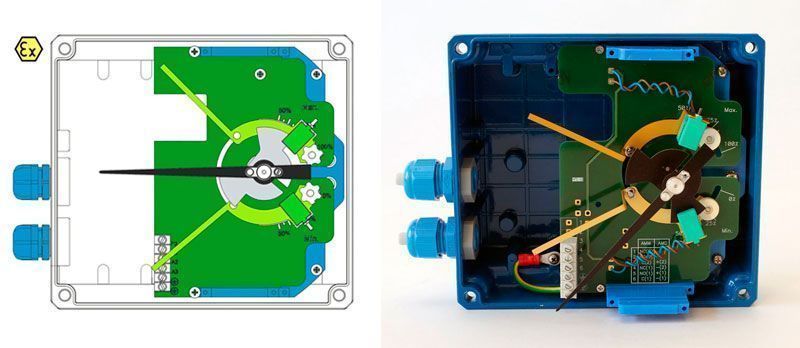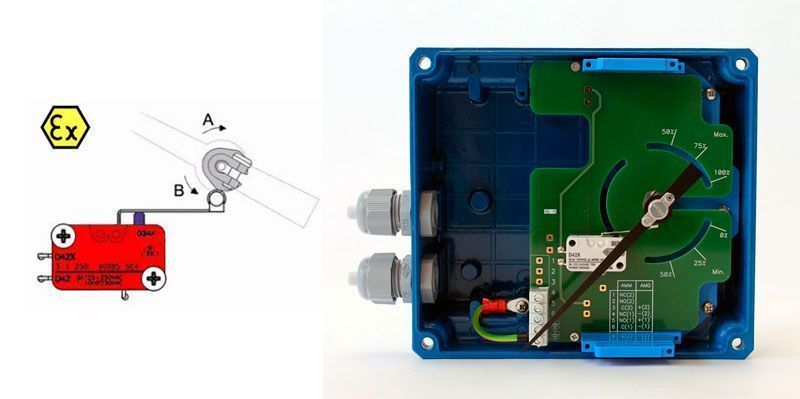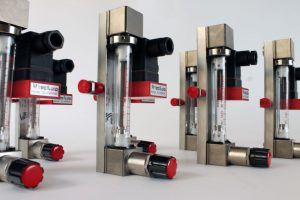What is a limit switch? We explain to you what it is, what it is used for and the keys to use the different types that we have with our variable area flowmeters.
In almost any industrial process composed of several machines incorporating switches can involve increasing productivity, functionality and even energy savings.
But what is a limit switch? A limit switch is a device capable of performing the function for which it was designed without the action of any operator.
“In almost any industrial process composed of several machines incorporating switches can involve increasing productivity, functionality and even energy savings”
What are the switches used for?
The switches allow us to automate a mechanical or electronic process without the need of a person in charge of following the necessary steps of this process. They can be used to generate a warning or an alarm when the flow rate measured by the instrument reaches a certain value in the measurement scale, whether it is a maximum or minimum flow. You just have to configure them for what you need them to do.
There are many types of switches: mechanical, pneumatic, hydraulic, electronic … In this article we are going to talk in particular about the switches for Tecfluid variable area flowmeters. Maybe you are interested to read this other article before about what is and how does a variable area flowmeter work.
Types of switches for variable area flowmeters
All our switches can be installed in an existing variable area flowmeter but it will depend on the characteristics of the flowmeter and the type of switch we want to install. Tecfluid have several limit switches that we are going to talk about in the article:
- AMD limit switch
- AMM limit switch
- AMR limit switch
AMD limit switch
The AMD switch is a NAMUR inductive sensor.
If we need a switch with ATEX certification for explosive atmospheres for our installation, this is the best option of all our switches for variable area flowmeters although in Tecfluid we also have other ATEX certified switches.
Depending on the flowmeter where it is mounted this switch will be installed and will act in a different way.
In series 2000 (Flow rate up to 6-60 l/h water & equivalent air ranges)

Available for 2100 & 2150 models
In these series it consists of a ring type inductive sensor that is actuated by the float. It can only be used when the material of the float is Stainless Steel.
In series 6000 (Flow rates up to 40-400 l/h water & equivalent air ranges)

AMD limit switch for series 6000
In series 6000 it consists of a 3,5 mm slot type inductive sensor actuated by the float magnetic field. It is mounted in an aluminium housing and acts by the float magnetic coupling on the inductive sensor vane, moving it from one detection position to another.
This state is maintained until the float passes in the opposite direction by the point where the flow detector is, returning again to the previous state.
In series M21 & SC250 (For all flow ranges)
In these series it consists of a 3,5 mm slot type inductive sensor. The sensor is mounted into an aluminium housing which includes a switching point indicator that indicates the switching position. The indicator needle moves together with the vane mounted on its shaft. When the vane enters into the slot of the sensor, the limit switch changes its state.

AMD limit switch for series M21 & SC250
Given that there is no physical contact in the operation, the limit switch has no influence on the indicator needle movement.
An instrument can be equipped with one or two sensors, depending on the number of points to be detected.
A NAMUR amplifier with a relay output can be supplied as an optional element.

The indicator, that is below the scale plate, can be seen through the scale slot.
Other characteristics of AMD limit switch:
- Power supply: 8 VDC
- Ambient temperature: -25°C … +70°C
- ATEX certificate Ex ia IIC T4…T6 Ga / Ex ia IIIC T85ºC Da
Control relay (accesory available on request)
NAMUR (EN 60947-5-6) for 1 or 2 inductive switches.
Power supply: 24 … 253 VAC 50-60 Hz
24 … 300 VDC
- Input: NAMUR Ex ia IIC
- Output: 1 or 2 relay contacts
- Output rating: 2 A 250 VAC 100 VA / 1 A 24 VDC
- Ambient temperature: -20°C … +60°C
AMM limit switch
The AMM limit switch is an electrical micro-switch.
Depending on the flowmeter where it is mounted, this switch will be installed and will act in a different way.
In series 6000 (Flow range from 40-400 l/h water & equivalent air ranges)

AMM limit switch for series 6000
In this type of flowmeters the AMM limit switch, an electrical micro-switch, is mounted in an aluminium housing actuated by a magnet inside the float.
Flow variations displace the float inside the measuring tube. The float, passing through the point where the AMM switch is, acts by magnetic coupling on a rotating system that presses the lever of the micro-switch, moving it from one contact position to another.
This state is maintained until the float passes in the opposite direction by the point where the flow detector is, moving the lever of the micro-switch back to its previous position.
In series SC250 (For all flow ranges)
The AMM switch for these series consists of a micro-switch driven by a cam mounted on the indicating needle shaft. An instrument can be equipped with one or two micro-switches depending on the number of points to be detected.

Cam shown acting on the micro-switch lever – Electrical micro-switch mounted in indicator housing
Other characteristics of AMM limit switch:
- Ratings: 3(1) A, 250 V (VDE/CEE)
- Hysteresis: ±10% of full scale value
- Ambient temperature: -25ºC … +80ºC
- Mechanical life: 107 operations
- Series 6000: Suitable for hazardous area, considered as “Simple apparatus”
Series SC250: ATEX certificate Ex ia IIC T4…T6 Ga / Ex ia IIIC T85ºC Da
AMR limit switch
The AMR limit switch is a bi-stable SPST reed switch.

In the standard version the set point is supplied as normally open (NA).
It can be also suppplied as normally closed (NC) under the same conditions on request if user so needs.
In series PS (For all flow ranges)

PS32 model DN80 with PVC connections
and AMR limit switch
In these series the switch is installed on a guide present in the same plastic measuring tube.
In series 2000 (Flow range from 10-100 l/h water & equivalent air ranges)

2100 model with AMR limit switch
In series 2000 the limit switch is installed by means of a metallic mounting bracket that fix the switch to the flowmeter stainless steel frame.
In this case the instruments with AMR switch are supplied without plastic protection shield.
In series 6000 (Flow range from 10-100 l/h water & equivalent air ranges)

6001 model with SS connections and AMR limit switch
In these series the switch is installed on a guide present in the plastic protection shield.
Other characteristics of AMR limit switch:
- Contact rating: 0,5 A, 250 VAC, 12 VA
- Hysteresis: ±5% of full scale value
- Ambient temperature: -15ºC … +60ºC
- Mechanical life: 107 operations
- Conforms to 2006-95-EC Directive
- Suitable for hazardous area, considered as “Simple apparatus”
Practically all the Tecfluid products have some option of adjustable switches (reed, inductive, micro-switch) and transmitters depending on the series that we choose.
Applications
In general, the different switches for variable area flowmeters available in the market, and in particular those of Tecfluid, allow us to perform actions as diverse as configuring different audible or visual alarms, opening or closing a valve, starting a pump, etc in our installation without having to have an operator to monitor the processes.

Series M21 flowmeters with painted aluminium housing, adjustable valve and AMD limit switch
We find them in control panels and pilot plants, installed in control and research laboratories, in control of gas burners and treatment furnaces, water treatment plants, industrial and process refrigeration, chemical and pharmaceutical industries and cosmetics … it is uncountable the large number of processes where limit switches can be used.
Now you only have to call us and ask us for the switch you need or to tell our Tecfluid Sales Engineer with whom you usually deal with any questions that you may have through this article. You can also contact us directly in our email or phone.
Interesting? Read other articles in our blog 🙂





